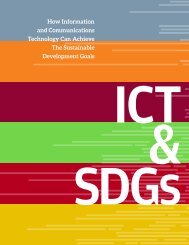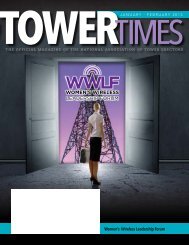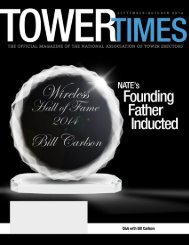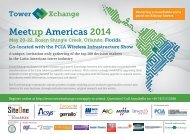Ou7h5
Ou7h5
Ou7h5
You also want an ePaper? Increase the reach of your titles
YUMPU automatically turns print PDFs into web optimized ePapers that Google loves.
ON ENERGY AND CLIMATE, ICTENABLES TRANSFORMATIONOur strategy is to maximize the energy performance of our products andsolutions, reduce the carbon footprint of our own activities, and drive thetransformation that enables a low-carbon economy.Ericsson takes a life-cycle approach toenvironmental management that includesraw material extraction, manufacturing,transport, use, disassembly and end-oflifemanagement. We focus on the followingthree areas:> > Reducing our own environmentalimpacts,> > Reducing environmental impacts fromour products and solutions in operation,> > Advocating and enabling ICT solutionsfor a low-carbon economy.Our life-cycle assessments consistentlyconfirm that Ericsson’s most significantenvironmental impact is the energy usedby our products in operation. O ur mainaim is to maximize the energy performanceof our products, services and solutionsto help customers optimize their networks(p. 30). We also seek to reduce the carbonfootprint of our own activities (p. 34).The ICT sector footprintThe ICT sector is responsible for about1.3% of total global greenhouse gas (GHG)emissions, according to the EricssonEnergy and Carbon Report (2014), whichlooks at the ICT sector’s own environmentalimpact in terms of electricity use andGHG emissions. It also includes an updateof our 2020 forecast for the sector’s GHGemissions.Even with the expected dramaticgrowth in mobile subscriptions, the totalICT impact is expected to account for nomore than 2% of the total GHG emissionsin 2020. This is largely due to advances intechnology, and industry-wide efforts toreduce energy consumption.However, in absolute terms the emissionlevels from ICT are still considerableand must be addressed. We prioritizeenergy performance throughout the networkto identify opportunities to reduceenergy consumption and GHG emissionsof mobile networks.The ICT enablement effectWhile the continued growth of the ICT sectorbrings with it a range of environmentalchallenges, we see huge potential for theICT sector to provide solutions that reduceglobal GHG emissions in other sectors. Infact, our research shows that the use ofICT has the potential to reduce global GHGemissions by approximately one sixth.ICT solutions help other sectors of societyto reduce GHG through dematerializationof physical products and systems, forexample, substituting travel with collaborativetools or substituting the need to producephysical products by deliveringe-products and services. Energy can begenerated, distributed and consumedmore efficiently through smart grids andsmart meters. ICT can also unlock efficiencygains in buildings, transportation,and logistics.Ericsson carbon footprint 2014Mtonnes CO 2e35302520151050–5˜ 3Measuring the impactIn 2014, we strengthened our focus onproviding solutions to help other sectors ofthe economy, primarily utilities and transport,to offset carbon emissions. In linewith this focus area, we set a target for2015: to reduce societal carbon emissionsby a factor of 2 in relation to carbon emissionsfrom Ericsson’s own activities in2014, by implementing ICT-enabled solutions,such as smart meters and smarttransport solutions.˜ 35 Supply chainActivities in 2014Own activities˜ 5˜ –0.3Future (lifetime) operationof products delivered in 2014Operator activitiesProducts in operationEnd-of-life treatmentApproximately˜Source: EricssonEnergy and Carbon ReportERICSSONENERGY ANDCARBONREPORTINCLUDING RESULTS FROM THE FIRST-EVER NATIONAL ASSESSMENT OFTHE ENVIRONMENTAL IMPACT OF ICTNovember 2014The Ericsson Energy and Carbon Report 2014focuses on the ICT sector’s own environmentalimpact in terms of electricity use and GHG emissions.It also includes an update of our 2020 forecast forGHG emissions of ICT; the first-ever national assessmentof the total GHG emissions attributable to theICT sector, and a detailed study of the life-cycleimpact of a smartphone. The research is a collaborationbetween Ericsson, telecom operator TeliaSonera,the KTH Royal Institute of Technology in Stockholmand Sony.Ericsson | Sustainability and Corporate Responsibility Report 201427







